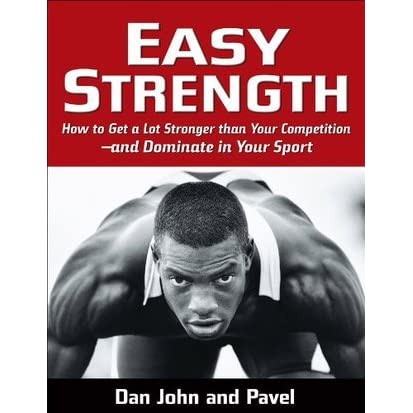Program Name
Easy Strength (Also “Even Easier Strength” and the “40 Day Workout”)
Price
Free
Author
Dan John and Pavel
Primary Goal
Strength
Secondary Goal
Hypertrophy (but likely only in lifters with little experience)
Special Focus
None
Program Length (in weeks). This program is originally a 40 day program, though it can vary depending on the trainee's preference
Training Days (per week). Can be as little as 3 and as much as 7.
Average Session Length (in minutes)
Primary Equipment
Barbell
Specialty Equipment
None (although it couldn’t hurt to have a couple kettlebells and/or dumbbells to vary exercise selection)
Novice Friendly?
Yes (it can be used as a means of learning fundamental lifting patterns, and getting stronger in the process)
Prerequisite Skills
- Squat variation (goblet, barbell back squat, front squat, etc)
- Press variation (overhead press, barbell bench press, etc)
- Deadlift variation (barbell, trap bar, kettlebell, suitcase, etc)
Program Overview
The Easy Strength program was developed by Dan John (with the help of Pavel Tsatsouline) to help athletes and lifters gain strength through daily (or near daily) submaximal training of compound lifts/movements.
The length of the program is ultimately the trainee’s choice, though the original plan was mapped out for a 40 day training cycle.
In Dan John’s write up of the program, Even Easier Strength, he explains several ways the workouts can be programmed including, but not limited to the following:

Why settle for less? Recognized by Google Play, MacroFactor is trusted by over 200,000 users worldwide for its adaptive coaching and verified food database. Take the guesswork out of nutrition and start seeing results!
Enter code INDEED for an exclusive 14-day free trial. Discover MacroFactor's award-winning features.
- One way is simply performing the same exercises and the same rep and set schemes 5-7 days/week for 40 days without any variation other than the weight the lifter “feels like lifting” that day.
- In another example, he programs training sessions in waves (5×5, 6×1, 3×2, etc).
- He also outlines a version where he focuses on unilateral training (i.e., train the left side of your body one day, and the right another).
- In several examples, he changes the lift variations after every two week block (e.g., switch from flat bench press to incline bench press).
The charm of this program (as well as the frustration for folks who want to be told exactly what to do), is that you can run it just about any way you want to, as long as you stick to it’s main tenants:
- Treat the workout like practice. Focus on the technique of the lifts involed, not necessarily how much weight you’re moving; strength will follow as you gain proficiency in the movement.
- Always train submaximally; often with a load you might warm up with.
- Never miss a rep. Ever.
- Stay consistent. As you’re rarely training near a max, workouts need to be very frequent (again, almost daily) in order for the program to “work”.
- Don’t go over 10 reps in any lift (with the exception of occasional explosive work, like kettlebell swings).
In the vanilla version of the workout (the original “40 day workout”), the following guidelines were given by Pavel:
For the next forty workouts, pick five lifts. Do them every workout. Never miss a rep, in fact, never even get close to struggling. Go as light as you need to go and don’t go over ten reps for any of the movements in a workout. It is going to seem easy. When the weights feel light, simply add more weight.
The workout template looked something like this:
- Press movement: 2 sets of 5 reps
- Pull movement: 2 sets of 5 reps
- Hinge movement: 2 sets of 5 reps
- Squat movement: 2 sets of 5 reps
- Loaded carry: vary the distance and/or load every day
Again, there are many ways to vary this program and progress accordingly as long as the principles of the program listed previously are followed. The workouts are frequent, but they’re also quick and easy (hence the name).
In the article, John discusses also using this program to help new lifters learn fundamental loaded movement patterns (e.g., goblet squats instead of back squats), as well as implementing the program to focus on corrective exercises (e.g., unilateral training for assymetries).
Dan John and Pavel Tsatsouline also wrote a book discussing the program in depth (often anecdotally), as well as its training application to athletes.
Reviews
But I have to say that Easy Strength could very well be the best book for a general trainee wondering how to organize their physical preparation for a sport.
I love the idea of short, effective workouts and the possibility of reduced injury risk. One big BUT though; if you’re going to follow the principles above, make sure that you have the background strength, stability, flexibility and joint range necessary to do so safely.
Easy Strength is one of the best books on strength training for sport that I’ve ever read (and trust me, I’ve read them ALL). To be fair—it’s unfair to characterize Easy Strength as a ‘strength training for sport’ book. It’s way more than that. It’ll go down as one of the best fitness and conditioning books period
Remember how I said that occasionally during max effort workouts I felt tired and couldn’t be bothered to train? Well here is the remedy; when you feel weak, lift lighter…when you feel strong you are allowed to push the weights above that magic 85% barrier.
Believe me, you’ll know when you feel strong, some days on my warm-up sets it felt like the bar wasn’t even on my back or in my hands! So I pushed the weights up. I also found that on Mondays, the first day of my training week, I felt weak on everything, but on Tuesday and Wednesday I felt like a machine, so I adjusted the weights accordingly.
Having a program that involves percentages as a guideline AND self-regulation is a great idea and really makes you feel good cos you can have a heavy day once in a while!
Results
I wanted to give credit and feedback as to the effectiveness of this program. I followed it as outlined on Dan Johns T-Nation article and picked the Bench press, Deadlift, Fat-bar inverted row, and rollout.
My warmups consisted of 5 getups and 50 goblet squats with 24k.
- Press increased from a shaky 285 to 315 for a smooth 2 reps no spotter.
- Deadlifts were done in the double overhand position and went from 405 to 485.
- Inverted rows were put in to balance the pressing volume and reinforce the pull into press groove, I used the same hand position as my press.
- The whole block I never used more than 225 on the press or 385 on the dead.
- When I pulled mixed grip on the dead I was able to pull my old max of 525 for a super smooth dead stop double.
Just wanted to share the success story of the program.
My results and some feedback about the program:
biggest mistake I made was to change up the movements too much every 3rd week. I went from back squat to front squat, from inclince press to overhead press and from deadlift to rack pulls (well below the knee) and by the time I switched back my strength on squats on benches had declined quite a bit.
- overhead strength barely improved. I worked up to 60kg the first time I tried singles w/o a problem. Had to really grind to get 65kg the second time.
- incline bench improved all right but I had done quite a big of volume before I got sick. So no problem hitting 90kg and I am sure I could have done more if I had stuck to it for the full 8 weeks.
squat more or less stagnated and the heaviest single I got was 120kg. - FS is not even worth mentioning.
- deadlift improved a lot. no idea why but I think the benzos and getting almost twice as much sleep as before played a big role. I worked up to 150kg for my sets of 5 without any problems and worked up to a solid 180kg on the singles day during my last week on the rack pulls.
- loaded carries were fun but I don’t know how to evaluate my progress
- my weight went up a total of 2kgs to a grand total of 93kg
Resources
- Even Easier Strength (John’s full outline of the program on DanJohn.net)
- The 40-Day Program (John’s full write up of the original program on T-Nation)
- Easy Strength: How to Get a Lot Stronger than Your Competition-And Dominate Your Sport (Dan and Pavel’s book on the program)
- Easy Strength Questions (answers in discussion format to some questions about the program, including a witty remark by Dan John)
- Great comprehensive guides to the “Big Three” powerlifts by Greg Nuckols


